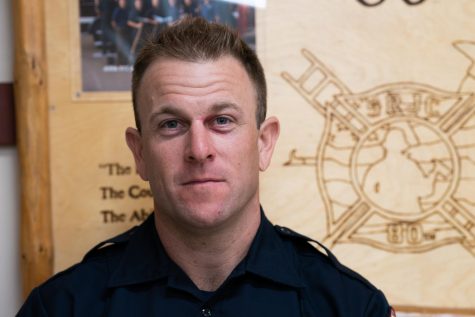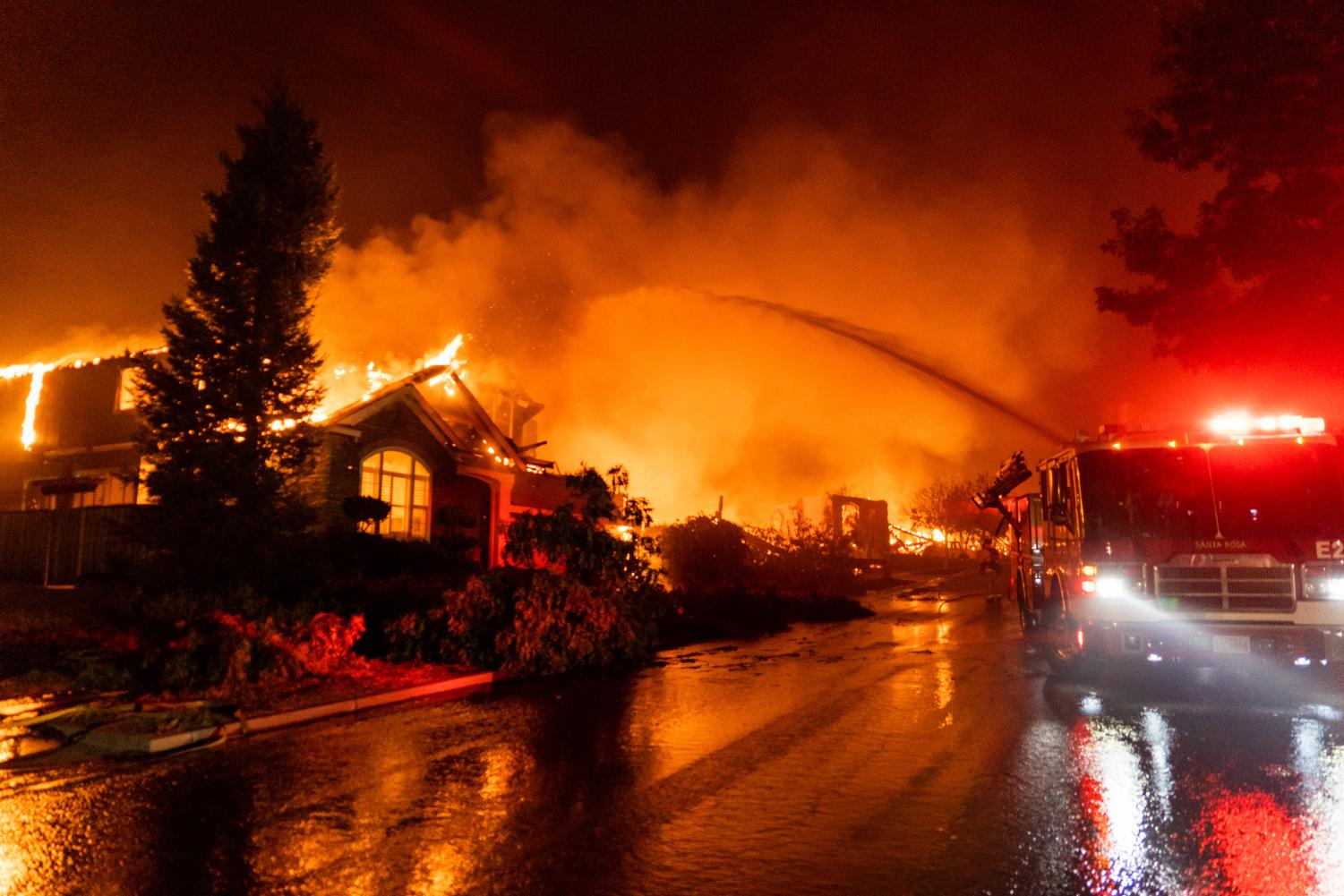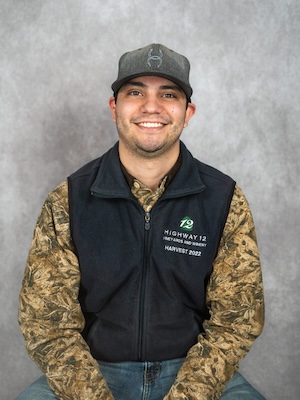In early 2017, Daniel Malcher’s niece fell off her scooter. He rushed to her side, scooped her up, cleaned her scrapes, motivated her to try again and sent her on her way.
The feeling of helping someone lingered with Malcher, so much so that a few months later he left his day job as a construction worker to become a personal trainer; he wanted to help people better themselves physically and emotionally.
When the Tubbs Fire hit in October 2017, Malcher performed community service, and his career trajectory changed again. Helping his niece, training clients and then volunteering in the disaster brought clarity.
“It kind of all came full circle,” Malcher said. “The smoke was in the air, and I thought, ‘That’s what I need to go do.’ And so from there on, I pursued the fire service.”
In the Spring 2019, he enrolled in Santa Rosa Junior College’s Emergency Medical Training Course, a prerequisite for the Firefighter Academy. The course’s difficulty, however, led him to withdraw.
The following spring, Malcher re-enrolled and passed, then took a year off from school to join a volunteer fire department in Dry Creek. Now he is enrolled and on track to graduate this December from the Firefighter Academy at SRJC’s Public Safety Training Center in Windsor.
Malcher is not an anomaly. Interest in the academy is up, thanks in part to recent natural disasters. “What the wildfires from 2017 through 2020 in our area did is motivate a lot of these people to become firefighters,” said Firefighter Academy Coordinator Kim Thompson.
According to SRJC’s Office of Institutional Research’s Fact Book, the Fall 2017 semester hosted 331 students in fire-related courses. After the Tubbs and Nuns fires, the Spring 2018 semester saw a 43.8% increase in student enrollment, with 476 students taking classes in the fire technology field. After 2019’s Kincade Fire, enrollment increased 19%, bringing the number of students taking fire-related courses from 347 to 413.

Behind the numbers are students who, like Malcher, felt a calling to serve their community. For Rebecca Gary, becoming a firefighter means she can help her home state. “I love California, but it burns a lot,” she said. “We tend to have a lot of evacuations and power outages and it’s very frustrating if you can’t do anything.”
She joined the academy after a five-year stint as a volunteer firefighter in Sonoma County. “This past year, I was looking through my photos, and the times that I was smiling was when I was volunteering,” she said. “So I decided to quit my job and join the [firefighting] program full-time to pursue what I’m really passionate about.”
Gary is one of two women trainees in the 40-person academy. She said being a woman in the male-dominated program is a non-issue. “[The instructors] don’t care about gender; they care about what they see,” she said. “The guys have been extremely supportive. We’re each compartmentalized into a squad of four people total. And all three of my squad mates are very supportive.”
For William Stinemates, joining the academy was a calling. “When you [dial] 911, you expect the fire department to show up. You expect them to be there,” he said. “They’re the ones problem solving, getting things done. That’s what drew me there.”
Stinemates’ goal is to work as a firefighter in Lake County. “That place just burns,” he said. “It’s one of the poorest communities in all of California. There’s a lot of glamor working in a city like San Rafael. It’s a beautiful place, but I think what a lot of people miss about the fire service is that it’s about serving the community that needs the most help.”
For all three students — and many of their classmates — the massive fires in 2017, 2019 and 2020 drew them into the JC’s Firefighter Academy.
But the rush of new students wanting to be firefighters created a bottleneck in enrollment. According to the Fact Book, 169 students wanted to take FIRE 208, a prerequisite to enter the academy, but could not take the course due to high demand in the 2021-2022 academic year. The newly added year-long session may help expand the Firefighter Academy’s accessibility.
In fact, interest in the program is so strong that administrators are adding a third session starting this spring, in partnership with the California Department of Forestry and Fire Protection, known colloquially as Cal Fire.
The new class is designed as a three-part course. The first stage will instruct students in a wildland component in which they will evaluate the fuel, weather and topography of a wildfire, learn to dig firebreaks by hand and execute progressive hose-laying maneuvers.
Students will also go through hazmat training, where they will learn how to wear and use personal protection equipment (PPE), how to assess hazardous chemical spills and how to properly decontaminate clothing and equipment.
The summer component will allow students to work alongside Cal Fire crews to experience life and work behind the firelines of next year’s disasters.
The third unit will conclude in the fall with the completion of Firefighter 1 and Firefighter 2, two certification classes established by the California State Board of Fire Services. These certificates enable trainees to find work with Cal Fire and local station houses that fight fires across the state.
“Basically once you come out of our academy, you can work on a fire engine,” said Ken Sebastiani, director of fire technology at SRJC.
Sebastiani said the idea of partnering with Cal Fire was well received by the agency. “We’re trying to be proactive and reach out and see if we can help people and do what a junior college should do and help the community be prepared for anything, education-wise and certification-wise,” he said. “Our bailiwick is the fire service.”
The third cohort will help both SRJC and the state meet demand. “Cal Fire is hiring hundreds if not thousands of people,” Sebastiani said. “At least 15 or so students out of 40 every academy are hired on by Cal Fire.”
Working for Cal Fire will always be in the back of Malcher’s mind due to its focus on wildfires. His goal, however, is to work for a city fire department.
“Ever since I started wanting to become a firefighter, San Francisco was always in the front of my mind,” he said. And he expects to learn from the best, which is why SRJC and its veteran instructors with years of field experience have been a great fit for him. “Regardless if they are retired or still in it, these guys were the best,” he said. “That’s how I look at seeing and getting knowledge from these instructors, is learning from the top guys — the firefighters that were in the thick of it.”
It’s a far cry from his prior experiences in higher education, where Malcher felt academic instructors weren’t superstars. “I went to the Academy of Art University. And the professors were great. They worked with a few directors and producers really high up,” he said. “But they weren’t the top notch people that you would love to be learning from like Spielberg, James Cameron or Jerry Bruckheimer.”
Respecting their instructors is critical because the techniques students must master can make a difference between life and death.
According to Sebastiani in a 2020 accreditation report, the origins of the JC fire program date back to the late 1960s when then-Dean Gene Portugal offered an 18-week “Basic Manipulative Skills” class. Demand was high, with 94 students coming from Marin, Mendocino, Lake, Napa and Contra Costa counties to attend sessions either at the Santa Rosa Fire Station on A street or at the old Naval Air Station in a building SRJC owned.
“The Academy is a little bit of everything [now]. It’s 585 hours. About a third of that is classroom lecture. The other two-thirds is hands-on work,” Thompson said. The physical components include dragging hundreds of feet of heavy rubber and nylon hoses, extinguishing mock house fires, swinging axes and sledgehammers to practice forced entry, and training while wearing heavy PPE.
The Firefighter Academy is currently offered twice a year; as a faster-paced Monday-through-Friday course in the spring, and an extended three-days-a-week format in the fall.
“Instructors want to see you succeed; they’re not here to just teach you,” Malcher said. “They’re here to mentor you, to push you, to drive you to be your very best that you can be because they were that once and they would love to be that again. That’s what I love about this center.”





